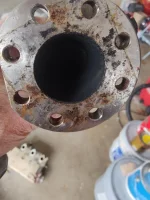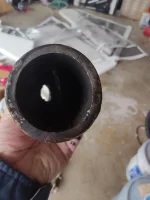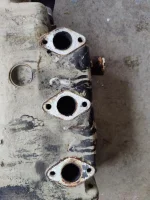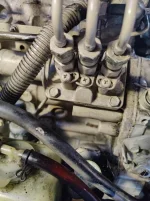Bob Bradley
Legendary Member
- Joined
- Apr 12, 2005
- Messages
- 3,661
- Hatteras Model
- 43' CONVERTIBLE-Series I (1978 - 1983)
I bought a boat with a Northern Lights NL753k genny a couple years back. Genny starts easily and runs well. No real complaints other than the fact that she smokes quite a bit. Dark gray exhaust smoke. Per the trouble shooting section of the manual, possible causes are:
Clogged or dirty air cleaner
Defective muffler (back pressure too high)
Improper fuel
Injector nozzles dirty
Engine out of time.
Valve adjustment needed.
Air cleaner is fine, fuel is fine, and I´ve replaced the injectors with new ones. I have the valve cover off and will be doing the valve adjustment while I'm in there.
From my research on Boatdiesel, I determined that corrosion in the exhaust elbow is a common cause of excessive back pressure on these engines. Original elbows were cast iron. I removed the elbow and found it had already been replaced with ss. I also pulled the exhaust manifold. Both are clear of any obstructions. I plan on replacing the exhaust hoses, hoping that perhaps they have failed internally and have a flap causing back pressure. I hate to just blindly replace the lift muffler not knowing if its good or bad. I'm not sure how a fiberglas muffler could fail to the point of creating back pressure. I should mention that the exhaust water does seem to "spurt" as it exits the system overboard. Can anyone tell me how to measure exhaust back pressure. I haven't removed the hoses yet, so I have the engine end of a 2" hose accessible to me to perform a test.
I'm not sure how to time the engine - manual does not address that. Suggestions on this would be appreciated too.



Clogged or dirty air cleaner
Defective muffler (back pressure too high)
Improper fuel
Injector nozzles dirty
Engine out of time.
Valve adjustment needed.
Air cleaner is fine, fuel is fine, and I´ve replaced the injectors with new ones. I have the valve cover off and will be doing the valve adjustment while I'm in there.
From my research on Boatdiesel, I determined that corrosion in the exhaust elbow is a common cause of excessive back pressure on these engines. Original elbows were cast iron. I removed the elbow and found it had already been replaced with ss. I also pulled the exhaust manifold. Both are clear of any obstructions. I plan on replacing the exhaust hoses, hoping that perhaps they have failed internally and have a flap causing back pressure. I hate to just blindly replace the lift muffler not knowing if its good or bad. I'm not sure how a fiberglas muffler could fail to the point of creating back pressure. I should mention that the exhaust water does seem to "spurt" as it exits the system overboard. Can anyone tell me how to measure exhaust back pressure. I haven't removed the hoses yet, so I have the engine end of a 2" hose accessible to me to perform a test.
I'm not sure how to time the engine - manual does not address that. Suggestions on this would be appreciated too.






